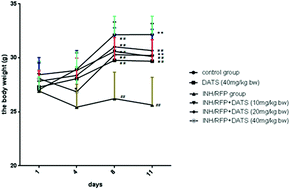Diallyl trisulfide protects the liver against hepatotoxicity induced by isoniazid and rifampin in mice by reducing oxidative stress and activating Kupffer cells
Abstract
Background & Aim: Diallyl trisulfide (DATS) has been verified to ameliorate hepatotoxicity induced by many drugs, but the protective actions of isoniazid (INH) and rifampicin (RFP) have not been reported. We attempted to elucidate the potential effects and mechanisms of DATS against INH&RFP-caused hepatotoxicity. Methods: Male Kunming mice weighing 18–22 g were divided into 6 groups. For the hepatic-protective study, DATS (10 mg per kg, 20 mg per kg, and 40 mg per kg bw, respectively) was orally administered two hours before the INH&RFP (100 mg per kg, 100 mg per kg bw, respectively) treatments. After 11 days of treatment, 10 mice in each group were taken for the carbon clearance test, while the other 10 mice were sacrificed for the collection of serum and livers for further measurements, including the levels of serum alanine aminotransferase (ALT), aspartate transaminase (AST) and total bilirubin (T.Bili), the liver index, and liver histopathological examination. Malondialdehyde (MDA), glutathione (GSH), and the level of interleukin 1-β (IL-1-β) were measured, the carbon clearance test was performed and the immunohistochemistry of F4/80 marker for activated Kupffer cells (KCs) was analyzed to investigate potential mechanisms. Results: DATS co-administration significantly inhibited the increase of liver index and elevation of serum ALT, AST and T.Bili levels induced by INH&RFP, as well as improved the hepatocellular structure. The further mechanistic studies demonstrated that DATS co-administration counteracted INH&RFP-induced oxidative stress in mice, which was illustrated by the restoration of GSH levels, and the reduction of MDA levels in the liver. Furthermore, DATS co-administration reactivated the KCs inhibited by INH&RFP, which was illustrated by the increase of carbon phagocytosis, and the restoration of the number of activated KCs and IL-1-β levels in the liver. Conclusion: DATS effectively protected the liver against INH&RFP-induced hepatotoxicity, which might be due to its antioxidant effect and enhancement of KCs’ activities.


 Please wait while we load your content...
Please wait while we load your content...